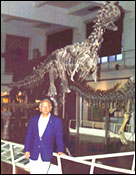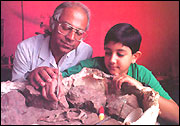From the moment he stepped into that deep, dark, tiger-infested forest, in Andhra Pradesh, Sankar Chatterjee knew he was not going to be an ordinary Ph D.
Thirty-seven years after that expedition near Hyderabad, Chatterjee's academic adventures have taken him across the world -- from Antarctica to remote parts of China and Latin America -- in search of dinosaurs fossils.
A best-selling author and an expert in his field, he is also a controversial scholar, whose theories about the evolution of birds, have frequently ruffled the feathers of other scholars. In fact, his passion and his accomplishments are so widely acknowledged, that it would not have been a wonder if Steven Spielberg had consulted Chatterjee, while he was making Jurassic Park.
But the 58-year-old professor and explorer has enough excitement and rewards from his own accomplishments. "The discovery, and the feeling that follows, when you know that no one has seen what you behold, is what drives us to take the challenges," he says.

Calcutta-born Chatterjee is now the Paul Whitfield Horn professor of geology and curator of paleontology at the museum of Texas Tech University at Lubbock, Texas. Among his most discussed accomplishments is the discovery of a 225-million-year-old avian fossil, Protoavis texensism, in west Texas 18 years ago. Many nations have released stamps honoring his discovery.
In his lectures and in his book, The Rise of Birds, 225 Million Years of Evolution, he contends that Protoavis, a pheasant-sized creature, may be the long-lost ancestor of all birds. He argues that though Protoavis predated Archaeopteryx -- whose discovery, in 1861, suggested that birds evolved from reptiles -- by 75 million years, "it is considerably more advanced than Archaeopteryx."
Chatterjee rejects the arboreal theory that dinosaurs began to fly from the ground up, pointing out, "So many feathered dinosaurs existed until a very unusual volcanic eruptions brought forth toxic gases which buried creatures in ash pits."
The paleontologist remembers his fascination with fossils from his India days... and the thrill he got naming his discoveries. "The fossil finder gets to name it," he says with pride. When he found several exquisite turtle fossils near Madras many years ago, the turtle expert at the Museum of Natural Sciences in New York asked him to name his discovery.
"I named it Kurmadelis after the dasha avatar." The kurma avatar is the second of the 10 avatars assumed by Vishnu to save the world, and it was in the form of a turtle, he explains.
Chatterjee began his career in America as a postdoctoral fellow at the Smithsonian Institution. But he longed to do research and undertake expeditions. When he wrote about his discovery of the turtle fossil to professors at the University of California, Berkley, they invited him over as a visiting professor in 1976. After his stint there, teaching geology and paleontology, he moved to George Washington University in Washington DC.
In 1979, he began research on the origin of dinosaurs and early birds, mass extinction and plate tectonics at Texas Tech. He was asked to take up where Dr Alton Wade, a pioneer for his work in Antarctica, left off, at his death. "My most challenging field trip was to Antarctica, which was life-threatening. Going there was taking a step where no one had walked before... that euphoria was worth the risk," says Chatterjee.
What made him settle down in Texas, his home for the last 20 years? "It is very much like India. Where else can you find such dinosaurs in your backyard?" he asks with a chuckle. "My heart was always in India," he admits.

The first opportunity he got, for an Indian research project, was in the early 1990s, when he went home to investigate the end of the dinosaurs. Along with his colleague, geologist, Dhiraj Kumar Rudra of the Indian Statistical Institute, Chatterjee concluded that a 375 mile (600 km) long crater, that he named after Shiva, now mostly submerged in the Arabian Sea off Bombay, may have been created by a giant asteroid smashing into the earth 65 million years ago. This triggered earthquakes, tidal waves and forest fires... and the ultimate death of the dinosaurs.
"We discovered skeletons of three dinosaur species, including an Indosuchus raptorius," he says. Like turtles, the dinosaurs laid eggs, in clusters, stretching 625 miles (1,000 km) across central India's lakes and rivers. Long after they perished, the waters dried up and the soil turned to limestone, trapping the unhatched eggs in rock formations. "The same kind of animals, Bangea, as seen in Indian fossils, are also found in Texas."
He has many wonderful memories of his discoveries. Chatterjee says his favorite is of what his seven-year-old son said to him,  11 years ago, that made him sit up. "Shivo would often tag along with me to the museum on summer evenings," he recalls. "This one evening, I had some work and so I told him not to disturb me. I gave him some rocks, which had been lying around from an expedition two or three years ago. I gave him a brush and asked him to look for fossils.
11 years ago, that made him sit up. "Shivo would often tag along with me to the museum on summer evenings," he recalls. "This one evening, I had some work and so I told him not to disturb me. I gave him some rocks, which had been lying around from an expedition two or three years ago. I gave him a brush and asked him to look for fossils.
"After a while he came back and said he had found something. I thought 'oh sure' and followed him. There it was... something I had never seen before, and so beautiful." His son had discovered a skull with no teeth. "I realized this was something brand new and named it Shivasarnous after my son."
Being good at discovering fossils does not come from teaching, says the paleontologist. "A 16-year-old village boy in Calcutta, with no schooling, watched us work each day," he says. "We invited him to join us and he turned out to be an incredible field person, with great intuition, and an ability to almost smell out the fossils."
This talented boy became well-versed in anatomy and went on to become a part of the scientific staff at the university.
Chatterjee's wife Sivani, a meteorologist, shares his love for the outdoors. "We take high school kids to digs," he says. Their two sons used to accompany them too, but they are now grown and have found their own fields of interest.
Chatterjee, whose honors include the Antarctic Service Medal and US State Department's Scientist of the Year, was in China last year for yet another expedition. Despite his love for India, he says China is a bigger draw.
"Often we need to find a place not inhabited by people, like the badlands of China," he explains. "There are no badlands in India, which is probably why not many dinosaurs are found." His current work includes investigations in geodynamics and possible impact-related phenomena in the Indian Ocean region. "India has huge departments but this field is most challenging and there are not many jobs available," he says.
He visits India frequently and hopes to set up a school for paleontology one day. "But the Indian psyche is hard to understand," he says. "Fifty miles from Bhopal I saw a sign that said 'World Heritage' and went there. If this was in America, I thought, thousands of people would have visited to see an early settlement of people." But there, there were very few.
Design: Lynette Menezes
Back to
top
Tell us what you think of this
report